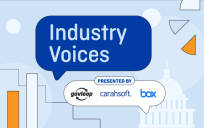What do government healthcare and agriculture strategies have in common? The increasing use of data analytics.
Data analytics has the power to transform governments – the way they operate, report, regulate, and plan for the future. In today’s GovLoop and NetApp roundtable discussion, “Breaking Down Data Analytics,” government leaders and industry experts gathered together to discuss how agencies can take their data analytics to the next level and create a robust data analytic strategy to overcome common data analytic challenges.
The possibilities for data analytics in government are endless. Imagine community and child nutrition being drastically improved through the use of sensors on farm tractors and planters. Just ask Joyce Hunter, Deputy Chief Information Officer, Policy and Planning at the US Department of Agriculture (USDA). The USDA is working to make these health improvements a reality. “We can now take samples of data from soil and seeds over a period of time and use the analytics to help farmers make healthier products.”
Imagine being able to stay at home for a medical checkup. With the use of biosensors, we could simply send our physical health data to the doctor. According to Dr. Joseph Ronzio, Assistant to the Chief Health Technology Officer in the Office of the Undersecretary of Health at Department of Veterans Affairs, this is what the healthcare industry is striving towards.
“We’re even reaching a point in data capabilities where you can help individuals change their life trajectory with individualized plans for diet and exercise,” Ronzio said.
While government is reaching new heights with data analytics, many agencies are still struggling with a number of issues, particularly in data structure, data integrity, and managing data on individuals. At today’s discussion, many individuals from government shared similar concerns and questions about managing their vast and disparate sources of data.
Industry experts like Steve Fritzinger, Business Development Manager for Net App’s Public Sector, and Sean Stauth, Director of Client Services at Silicon Valley Data Science, shared their insights on data analytics challenges and potential solutions in the public sector.
“Many are wondering how we integrate so much data from disparate bits into sensible data that you can ask questions and get information out of,” Fritzinger said. “The public sector has to get ready and plan for the growth of managing data. It’s about taking baby steps. A lot of organizations get into trouble because they try to take a big leap.”
Stauth advises that it’s all about the questions you’re trying to ask of your data. “The technical challenge is starting with an investment that makes sense and gives your organization certain value. But that has to start from a clear mission of what you’re trying to accomplish.”
While the challenges are daunting, government can at least be rest assured that it’s on the right path. Today’s fruitful discussion yielded some helpful tips that government agencies should be aware of as they surge on with their data analytics challenges:
- Understand your limitations. Understand your agency’s data strengths and weaknesses. Where are the gaps in your data? How can you begin to address those? Be honest and know that your agency can’t achieve superior data analytics overnight. Be ready to set goals that could be as far as 10 years down the road. If you know what your limitations and capabilities are, you can also share tips and best practices with other agencies. Be upfront about what your organization has and what it can provide.
- Become data stewards. Data is not just managed by database administrators anymore. Now, almost everyone in an organization has a responsibility to understand your agency’s data. It’s up to everyone in an organization, regardless of role or title, to become data stewards. Form a working group in your agency to specifically focus on data issues. For example, USDA formed a working data group to universalize data standards and terminology for the 27 various departments under the organization.
- Use the metadata too, not just the data. It’s just as important for government agencies to understand the data about the data – aka the metadata. This helps you understand your data sources and whether those sources are trustworthy. If you don’t keep track of the metadata, then it will be increasingly difficult to depend on your data analytics. Keep track of where your agency’s data is actually coming from.
When breaking down data analytics, it’s clear that there are many challenges for government ahead. It may take some time, reorganizing, and re-strategizing to achieve the full data analytical capabilities within government. Government may have to crawl, walk, then, run towards the future of data analytics. But if agencies take well-planned and deliberate steps, they can be more confident in achieving their full data analytics potential.





Leave a Reply
You must be logged in to post a comment.